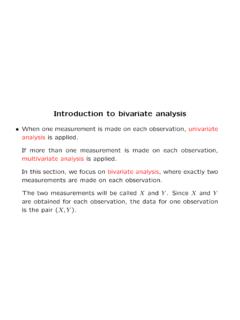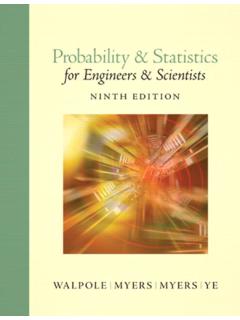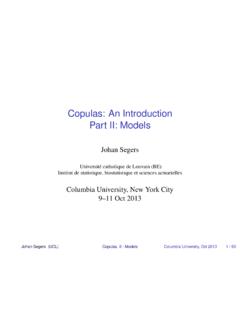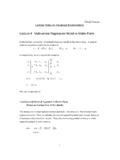Transcription of Prediction of the FIFA World Cup 2018 { A random …
1 Prediction of the FIFA World Cup 2018 A randomforest approach with an emphasis on estimated teamability parametersAndreas Groll Christophe Ley Gunther Schauberger Hans Van Eetvelde June 8, 2018 AbstractIn this work, we compare three different modeling approaches for the scoresof soccer matches with regard to their predictive performances based on all matchesfrom the four previous FIFA World Cups 2002 2014:Poisson regression models,ran-dom forestsandranking methods. While the former two are based on the teams covari-ate information, the latter method estimates adequate ability parameters that reflectthe current strength of the teams best. Within this comparison the best-performingprediction methods on the training data turn out to be the ranking methods and therandom forests. However, we show that by combining the random forest with theteam ability parameters from the ranking methods as an additional covariate we canimprove the predictive power substantially.
2 Finally, this combination of methods ischosen as the final model and based on its estimates, the FIFA World Cup 2018 issimulated repeatedly and winning probabilities are obtained for all teams. The modelslightly favors Spain before the defending champion Germany. Additionally, we pro-vide survival probabilities for all teams and at all tournament stages as well as themost probable tournament : FIFA World Cup 2018, Soccer, random forests, Team abilities, Sportstournaments. Statistics Faculty, Technische Universit at Dortmund, Vogelpothsweg 87, 44227 Dortmund, Faculty of Sciences, Department of Applied Mathematics, Computer Science and Statistics, GhentUniversity, Krijgslaan 281, 9000 Gent, Chair of Epidemiology, Department of Sport and Health Sciences, Technical University of Faculty of Sciences, Department of Applied Mathematics, Computer Science and Statistics, GhentUniversity, Krijgslaan 281, 9000 Gent, [ ] 13 Jun 20181 IntroductionLike the previous FIFA World Cup 2014, also the up-coming tournament in Rus-sia has caught the attention of several modelers who try to predict the tournamentwinner.
3 One approach that has already produced reasonable results for severalof the past European championships (EUROs) and FIFA World Cups is based onthe prospective information contained in bookmakers odds (Leitner, Zeileis, andHornik, 2010b, Zeileis, Leitner, and Hornik, 2012, 2014, 2016). Nowadays, forsuch major tournaments bookmakers offer a bet on the winner in advance of thetournament. By aggregating the winning odds from several online bookmakers andtransforming those into winning probabilities, inverse tournament simulation canbe used to compute team-specific abilities, see Leitner, Zeileis, and Hornik (2010a).With the team-specific abilities all single matches are simulated via paired compar-isons and, hence, the complete tournament course is obtained. Using this approach,Zeileis, Leitner, and Hornik (2018) forecast Brazil to win the FIFA World Cup 2018with a probability of , followed by Germany ( ) and Spain ( ).
4 The same three teams are determined as the major favorites by a group ofexperts of the Swiss bank UBS, but with different probabilities and a different order(Audran, Bolliger, Kolb, Mariscal, and Pilloud, 2018): they obtain Germany astop favorite with a winning probability of , followed by Brazil ( ) andSpain ( ). They use a statistical model based on four factors that are supposedto indicate how well a team will be doing during the tournament: the Elo rating,the teams performances in the qualifications preceding the World Cup, the teams success in previous World Cup tournaments and a home advantage. The model iscalibrated by using the results from the previous five tournaments and 10,000 MonteCarlo simulations are conducted to determine winning probabilities for all model class that has proved of value in predicting the outcomeof previous international soccer tournaments, such as EUROs or World Cups, is theclass of Poisson regression models which directly model the number of goals scoredby both competing teams in the single matches of the tournaments.
5 LetXi jandYi jdenote the goals of the first and second team, respectively, in a match betweenteamsiandj, wherei,j {1,..,n}andndenotes the total number of teams inthe regarded tournaments. One assumesXi j Po( i j)andYi j Po( i j)where i jand i jdenote the intensity parameters ( the expected number of goals) of therespective Poisson distributions. For these intensity parameters several modelingstrategies exist, which incorporate playing abilities or covariates of the competingteams in different the simplest case, the Poisson distributions are treated as (conditionally)independent, conditional on the teams abilities or covariates. For example, Dyteand Clarke (2000) applied this model to data from FIFA World cups and let the2 Poisson intensities of both competing teams depend on their FIFA ranks. Groll andAbedieh (2013) and Groll, Schauberger, and Tutz (2015) considered a large set ofpotentially influential variables for EURO and World Cup data, respectively, andusedL1-penalized approaches to detect a sparse set of relevant covariates.
6 Based onthese, predictions for the EURO 2012 and FIFA World Cup 2014 tournaments wereprovided. These approaches showed that, when many covariates are regarded and/orthe predictive power of the single variables is not clear in advance, regularizedestimation approaches can be researchers have relaxed the strong assumption of conditional inde-pendence and have introduced different possibilities to allow for dependent and Coles (1997) were the first to identify a (slightly negative) correlationbetween the scores. As a consequence, they introduced an additional dependenceparameter. However, they ignored the fact that the intensity parameters in modelsincluding abilities (or covariates) of both teams are themselves correlated. There-fore, even though, conditional on the abilities, the Poisson distributions are assumedto be independent they are marginally correlated.
7 Karlis and Ntzoufras (2003) pro-posed to model the scores of both teams by a bivariate Poisson distribution, whichis able to account for (positive) dependencies between the scores. While the bivari-ate Poisson distribution can only account for positive dependencies, copula-basedmodels also allow for negative dependencies (see, for example, McHale and Scarf,2007, McHale and Scarf, 2011 or Boshnakov, Kharrat, and McHale, 2017).However, with regard to the bivariate Poisson case, Groll, Kneib, Mayr, andSchauberger (2018) provide some evidence that, if highly informative covariatesof both competing teams are included into the intensities of both (conditionally)independent Poisson distributions, the dependence structure of the match scores canalready be appropriately modeled. They included a large set of covariates for EURO data and used a boosting approach to select a sparse model for the Prediction of theEURO 2016.
8 As the dependency parameter of the bivariate Poisson distribution wasnever updated by the boosting algorithm, two (conditionally) independent Poissondistributions were related to the covariate-based Poisson regression models are Poisson-based ranking methods for soccer teams. The main idea is to find adequate abilityparameters that reflect the current strength of the teams best. On basis of a set ofmatches, those parameters are then estimated by means of maximum , Van de Wiele, and Van Eetvelde (2018) have investigated various Poissonmodels and compared them in terms of their predictive performance. The result-ing best models for this purpose are the independent Poisson model and the sim-plest bivariate Poisson distribution of Karlis and Ntzoufras (2003). Interestingly,Ley et al. (2018) found that those models outperform their competitors both for do-mestic league matches and national team matches.
9 These statistical strength-based3rankings present an interesting alternative to the FIFA fundamentally different modeling approach is based on random (deci-sion) forests an ensemble learning method for classification, regression and othertasks proposed by Breiman (2001). The method originates from the machine learn-ing and data mining community and operates by first constructing a multitude ofso-called decision trees (see, , Quinlan, 1986; Breiman, Friedman, Olshen, andStone, 1984) on training data. The predictions from the individual trees are thensummarized, either by taking the mode of the predicted classes (in classification)or by averaging the predicted values (in regression). This way, random forests re-duce the tendency of overfitting and the variance compared to regular decision trees,and, hence, are a common powerful tool for Prediction .
10 In preliminary work fromSchauberger and Groll (2018) the predictive performance of different types of ran-dom forests has been compared on data containing all matches of the FIFA WorldCups 2002 2014 with conventional regression methods for count data, such as thePoisson models mentioned above. It turned out that random forests provided verysatisfactory results and generally outperformed the regression approaches. More-over, their predictive performances actually were either close to or even outper-forming those of the bookmakers, which serve as natural benchmark. These resultsmotivate us to use random forests in the present work to calculate predictions ofthe up-coming FIFA World Cup 2018. However, we will show that the already ex-cellent predictive power of the random forests can be further increased if adequateestimates of team ability parameters, reflecting the current strength of the nationalteams, are incorporated as additional rest of the manuscript is structured as follows: in Section 2 we describethe underlying data set covering all matches of the four preceding FIFA World Cups2002 2014.
![arXiv:0706.3639v1 [cs.AI] 25 Jun 2007](/cache/preview/4/1/3/9/3/1/4/b/thumb-4139314b93ef86b7b4c2d05ebcc88e46.jpg)

![arXiv:1301.3781v3 [cs.CL] 7 Sep 2013](/cache/preview/4/d/5/0/4/3/4/0/thumb-4d504340120163c0bdf3f4678d8d217f.jpg)
![@google.com arXiv:1609.03499v2 [cs.SD] 19 Sep 2016](/cache/preview/c/3/4/9/4/6/9/b/thumb-c349469b499107d21e221f2ac908f8b2.jpg)











